
Volume 45 - Spring 2018
A Short Treatise on the History and Use of the Electric Backing Hammers
Comprising an Accurate and Popular View of the Present Improved State of Human Knowledge - by Jeff Peachey
Reprinted with permission from jeffpeachey.com. This was originally posted on April 1, 2011. Please note this was originally posted on April 1, 2011. Pay attention to the date, April 1, 2011.
Since the time of the ancients, bookbinders have struggled to back books quickly and efficiently. Early on, they avoided it entirely by naturally rounding and backing, later they would locate the nearest large hammer and apply it with great force to the spine of the book. Even though this is great fun, after a while, the hand and arm tire, the mind wanders and bookbinders began to dream of mechanical devices to accomplish this task, which culminated in the electric backing hammer. The origins of this hammer are unknown, and the last known example, thought to be made in the 1960's, is represented by a single surviving example. I trust that this small contribution to the history of bookbinding will, perhaps, demonstrate the importance of this almost forgotten tool. So, dear reader, let us take a brief tour of the illustrious, noble, and little known history of electric backing hammers.
First of all, however, I most humbly and modestly would like to point out that all scholarship concerning the history of the book is a load of crap. Below is a book, printed by moveable type, in my possession, from the year seven. This pushes back the origins of movable type by fourteen centuries.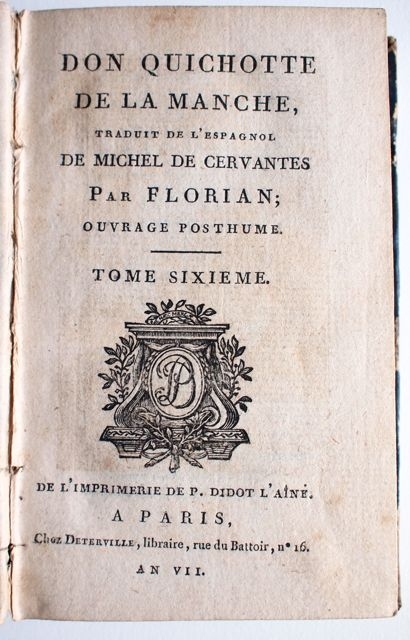
An example of a book printed in the year 7. The binding has an ms. inscription on the upper board that mysteriously reads, "BOUND for lil' J. CHRIST". I would be extremely interested to find J. CHRIST - any information as to his whereabouts is much appreciated.
Anyhoo, there are virtually no references to backing, and especially electric backing hammers until the 17th century. The first reference we have to an "Electro backing Hammer" is found in the c. 1694-5 broadside of a bookbinder's sequence of operations known as "The Bookbinders Case Unfolded", which was found bound into Samuel Pepys copy of Moxon's Mechanick Exercises. Bernard Middleton wrote about this broadside, which is considered the earliest detailed description of English bookbinding, although inexplicably, passed over the reference to electro hammer without comment. [1] There are no known examples of this hammer.
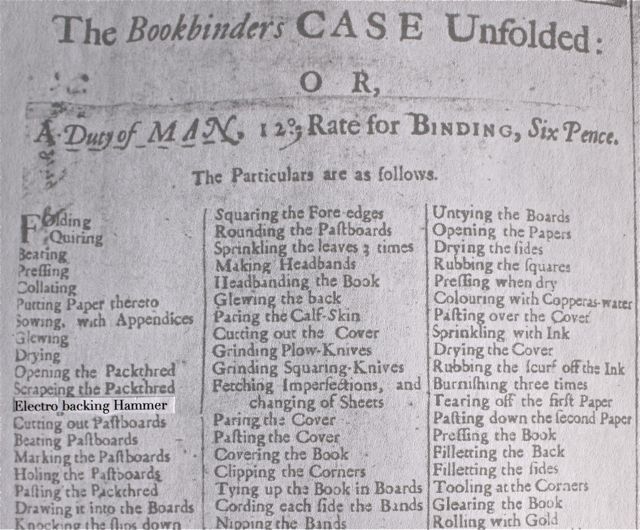
The earliest known reference to an 'electro backing hammer', c. 1694-1695.
Believe it or not, many so-called 'authors' from this time didn't even know the difference
between an "f" and an "s"!
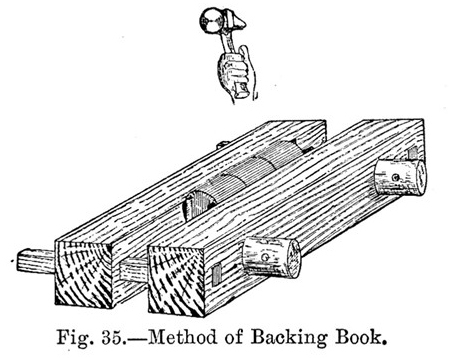
An early 'magic hammer'. Mirrors hide the source of power for this floating hand?
The Magic Hammer, c. 1470-1908
Most illustrations, like the image above, originally from 1467, but redrawn and used numerous times, are at best a bit vague as to the exact mechanism involved. There is a chance that this might be an early mechanco-electric powered hammer. Although the title misleadingly reads, "Method of Backing Book", the author neglected to include any actual information about this method of backing a book. The reader is left with the impression that a hammer is held over a book then, presto, it is backed, magic. Around the time of the Enlightenment, the first automatic style backing hammer makes its appearance.
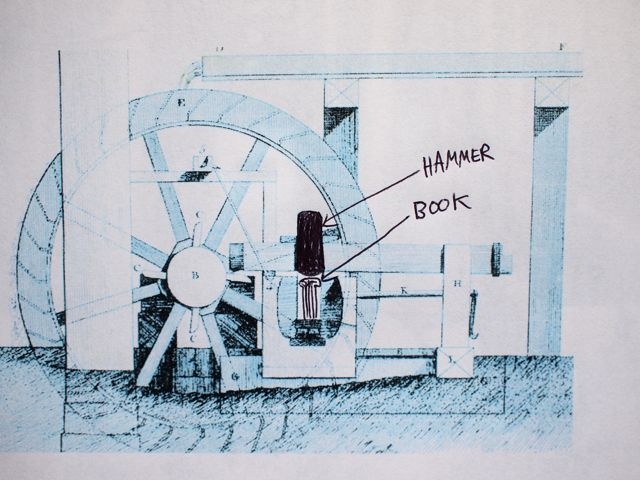
Above is a French water powered book backing machine, c. 1767.
Le Gros Marteau, c. 1750-1810
The first actual record of an automatic book backing hammer, Le Gros Marteau, is pictured in Diderot's magnificent encyclopedie. The limitless power of a running stream is harnessed to replace the toil and drudgery of the bookbinder. This ponderous mechanism may account for the unusually solid, inflexible spines usually found of French books of this time, and even today in French fine bindings. By the by, in 2007, French fine binders purchased 27% of the world's sandpaper. This water powered hammer is an ancestor to the electromagnetic hammer of the 1960's. Notice it is big. Modern style people like small things: cell phones, tic-tacs and the Fiat 500. Modern style people don't like big things like this machine, but they do like big screen television, but it has to be thin in its thickness. But I digress. And I will digress further. Notice the exceptionally fine decoration depicted on the edge of the book, pictured above. It appears to be some kind of gauffered allegory. The scene depicted is difficult to interpret - perhaps the wolf child is running towards liberty? Why is it's mouth slightly bleeding? What is the strange symbol on the flag down near the fore-edge? Could this bizarre scene somehow be interpreted as fear or anxiety about the machine replacing human labor?
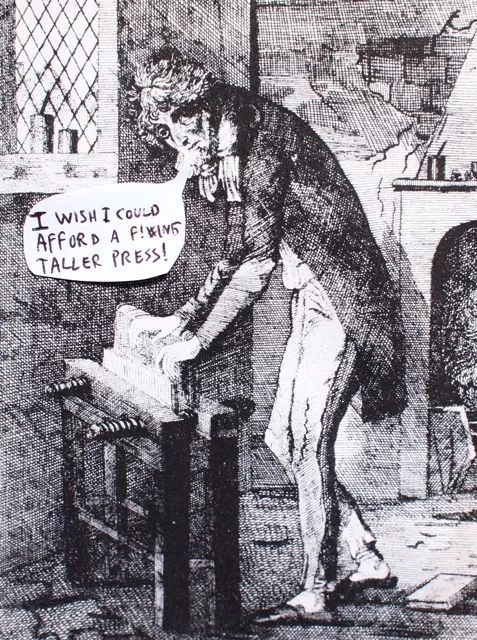
A happy and contented Roger Pain demonstrates the backing position known in the trade as 'coat hanger'.
The English Children's Hammers, c. 1790-1880
This illustration of Roger Pain makes it clear that these knee high press-tubs were generally used by children and hunchbacks. Why is he wearing his bedroom slippers, and backing an already covered book with his hands?[2] This etching dates from 1700 & something, I got tired counting all the "X"s and "I"s. Why were those people so stupid that they didn't write real numbers?
The French were a bit more advanced in their book backing technologies, and after Le Gros Marteau, they mostly dispensed with hammers altogether, instead using the elegant, fantastically designed, sophisticated, efficient, and vastly superior in all respects tool called le froittoir (ON SALE NOW !). Mechanization in late eighteenth century England was generally avoided in preference to child laborers and hunchbacks. Some of the terminology of olden times is confusing- children were often treated like 'little adults', especially when they were married at age eight. But what if they actually were little adults? Maybe smaller adults are fewer vittles? And if children ate fewer vittles, maybe they became smaller adults?
The English contributed greatly to the history of book backing by offering young children the opportunity to play alongside adults. By the early nineteenth century, bookbinders backing hammers were marketed specifically for children. They were sized "000" to "4", with size "000" used for 5 year olds, "00" for 6, and so on. Small pieces of rock candy was given as rewards for the children upon meeting production goals and submitting properly formatted quarterly reports.
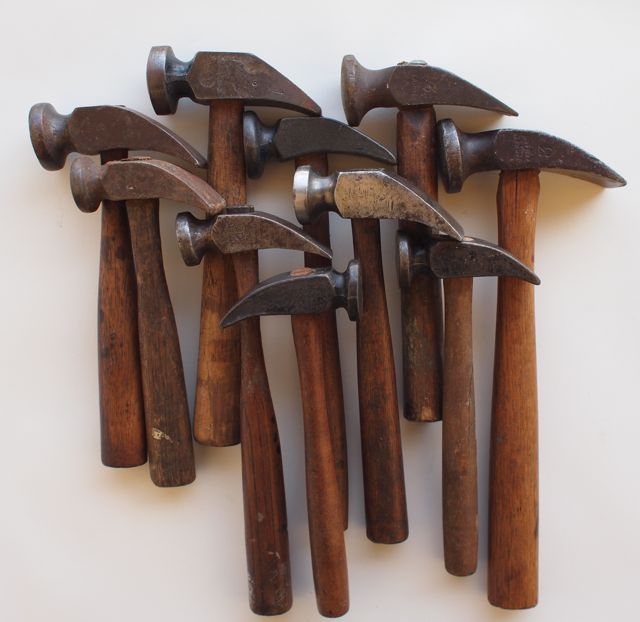
An assortment of 19th century backing hammers. They are all stamped "Made for Children" on the cheek not shown.
Notice how dirty they are. Everything, and everybody, was dirty in olden times!
The Song of the Hammer, c. 1840-1916
To ease the oppressive burden of their labors, the children would often sing songs while backing books. Even today, many ye olde bookbinders cannot help singing along when they hear the words below, which were painstakingly beaten into their skulls, one signature at a time, over the course of decades:
"The plough we move so swiftly,
The hammer wield so deftly,
Upon the beating stone.
In rounding or in backing,
We find no music lacking,
Each has its merry tone.
CHORUS:
Hallo, halli, hallo, halli
The Binder's life for me. [3]
Child labor was one of the great delights of the olde days- men and women would often have plenty of spare time to write their names with lots of curlycues. But eventually the teeming masses of children workers could not keep up with the onslaught of books spit from the mouth of the cylinder press. Unbacked books began to pile up in enormous warehouses. Factory owners grew morose and stared out of coal stained windows, eyes focused on the horizon, while their teeth clenched ever tighter around an unlit cigar. Something needed to be done.

Because of the demands of the work, bookbinder food was invented. Snapper soup proved ideal.
At first it was thought special diets might help the workers keep pace with production demands. During the last half of the nineteenth century, many different companies produced bookbinder food, and Snapper Soup was very common. The penial gland of the red snapper fish contains a vital fluid which is essential for the productivity of bookbinders. Similarly, most bookbinders today, myself included, need to dine on premium quality sushi at least twice a week. Alas, even this unusual dietary supplement was not enough to help the child laborers keep pace. A more rapid means of production had to be found. The scientists were forced to turn to their last resort: science. The stage was set. The field was ripe for the induction of electromagnetism.
The Electric Backing Hammer, 1890-1970
Karen Hanmer sent me this bit of personal history, which fills a small gap in this still largely undocumented history.
I hear you are looking into the origins of the electromagnetic hammer, and I have a connection to what might be a precursor to the one in Peter's collection. Before Nikola Tesla built his own laboratory in Colorado Springs in 1899, he rented space in the same building as my great grandfather Josip, the town bookbinder. They were both part of the small, close-knit Slavic community there. Grandpa Josip was beginning to get arthritis, and backing was very difficult and painful. Tesla moved the job backer into his shop, and wired it in series to Grandpa's backing hammer and a huge rack of vacuum tubes. The electricity flowing between the hammer and the jaws of the job backer resulted in a 90 degree shoulder with very little physical effort. Tesla was not able to complete the wireless version of the electromagnetic hammer before he left Colorado Springs to return to New York in January of 1900. My grandfather would tell wonderful stories about the magical happenings in the workshop shared by his father and "Uncle Nikki." I'm sure this is why I became a bookbinder and my brother became an electrical engineer. [4]
There might be an interesting connection between the electrified job backer, and the electric rounding and backing machine, of which Tesla is know to have investigated. The Tesla connection is complicated by the information provided by Tom Conroy, "I believe the Edison Reciprocating Rounding Hammer and the Edison Rotary Backing Hammer were regarded as tools of potential value, but the designs were never successfully converted from direct current to alternating current. Westinghouse took a different tack, but made the mistake of trying to mass-produce and market their version as a necessity for every household. That didn't fly well, though it had no effect on the basic uselessness of the tool." [5]
Although we know that Tesla worked for Edison, and Edison essentially cheated him out of a huge bonus for redesigning Edison's DC motor, when he began, or gave up, on the AC backing hammer is still unknown. Similarly, the next half century is essentially devoid of information related to electric backing hammers. But we do know that the first, commercially viable electric backing hammer began production in 1966, in West Germany, and was marketed and distributed worldwide.
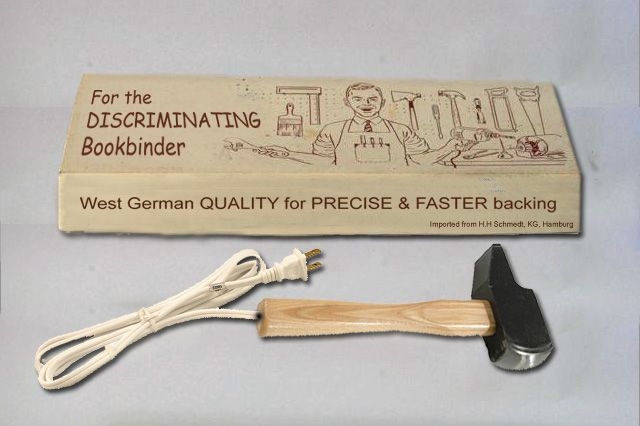
The only extant electric backing hammer, collection of Peter Verheyen.
Peter Verheyen, has the only electric backing hammer that this author is aware of. Peter writes, "This backing hammer features electrically activated percussive action on both sides of the head for precise and faster backing for today's less robust binders." [6] Peter is an expert on less than robust bookbinders, and he seems to know a bit about backing as well. I visited Peter, in an attempt to try out this rare bird. The head rotates on an axis to the handle, mimicking the proper hand motion. Since this hammer is the only known example and was basically NIB, and Peter requested I only visually examine it. I was not able to plug it in and try it out, so I do not know how rapidly it can jitterbug out of control then make dents on his workbench and I also do not know how easily the face can become chipped when it falls on the floor.
Later, I managed to track down a few bookbinders who recalled using this sublime exemplar of the toolmakers art, although none could locate the actual hammers. Recollections of the hammer provoked a variety of responses:
"I don't 'member that much about it.... a plug, you say?"
"Bloody beast was horrible. Least I couldn't hear the darn child'n singin."
"Tingled me toes when I wore steel toed boots. YEE-HAW!"
"You ever hit your stinkin' thumb with a stinkin' hammer? Imagine doin' it with this devil, fer christsakes!!"
"It was great for vellum manuscripts- 'specially the early ones -I rebound all of them in our collection with perfect 90 degree shoulders. Here is a little bookbinder secret- this beauty makes it much easier to put a LOT of PVA on the spines."
A Recent History of the Electric Backing Hammer
And although I thought this might be the end of the electric backing hammer story, the Anonymous Bookbinder sent me this account of his recent experiences:
W.O. Hickok discontinued the electric backing hammer (their model #WOH13459) at the same time they discontinued regular production of most of their traditional binding equipment (not sure of the actual date). However, as with all of their binding equipment they continued to offer it as a made to order item from the original molds and patterns. I first learned about this from an acquaintance at the old Ruzicka Bindery in North Carolina (since bought out by Etherington Conservation, Inc.). They ordered a gross of polishers (the manual version) but found the barrels were not attached to the shaft at 90 degrees, which of course made them useless. Apparently, without the old master toolmakers around no one really knew what they were and could not properly interpret the drawings. At first they thought it was an "offset" bookbinding hammer, according to the guy at Ruzicka.
At any rate, about two years ago I inquired about the electric backing hammer. My original one is still more or less in working order, but it's pretty banged up (no pun) after a carpenter putting in a new set of steps to my building "borrowed" it. I thought that since the electric hammer was a bit more modern than polishing irons they might still be able to do a passable job on a custom order. After several transfers I eventually talked to a young archival engineer at Hickok who seemed pretty eager to look into it. Long story short, he said he could use the original drawings to do a cordless version (12V, which may explain the lack of umph). As I had just signed a contract for hand binding the print version of Wikipedia (hence the digitally enhanced endpapers) I thought it worth a shot and Hickok offered to defer the development cost if I bought a dozen. Given the scale of the project and the special pricing ($675.00 ea) I though this was worth a go. But the results were as I previously reported.[7] I can send you one to try for yourself if you'd like. Maybe T. Conroy should have one for the Bookbinder's Museum, if he doesn't already. Do they have an outdated technology section?
Anyway, it was this same archival engineer who told me about the pending IEEE 802.11q standard. After I sent him my review of the cordless model (which really ticked off Hickok-no more free development) he said he was interested in going for low frequency wireless electric. He thinks it will change the world-wireless electric, not the backing hammer. I don't hold out much hope for either, especially for those of us this far off the grid. But I've been wrong before.[8]
The Effects Of Electric Backing Hammers
Although electric backing hammers are practically extinct, there are hundreds of thousands, if not millions of book spines that at least to this conservators eye, look to have been electrically backed. The rapid blows create an almost pointillist scene on the spines, quite distinctive, sometimes quite pretty, and one time eerily reminiscent of Seurat's Sunday Afternoon on the Island of La Grand Jatte. In fact, there often is no shoulder, just a depraved, gaping concavity in the center of the spine. An unbelievable number of books have suffered this total spinal obliteration, as illustrated below.
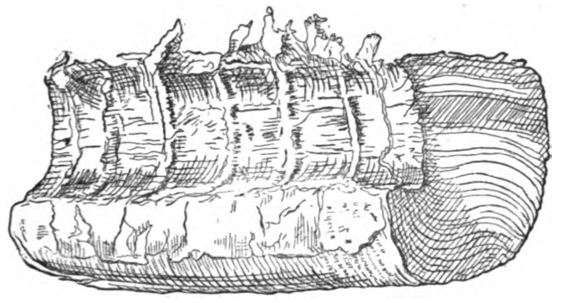
A book that has been backed to death. This damage is difficult, and very, very costly to repair :)
I presume that many conservators have seen examples of similarly depressing vandalism. Books that have been electromagnetically backed range from disastrous to preposterous to maliforous. They are distressing to encounter, yet it is important to understand and analyze how the tools and techniques of earlier bookbinders could have caused such damage. A book conservator's job would be much easier if bookbinders would have left the books alone and satisfied their craft urges by gluing little old things into a printer's type drawer and hanging it on the wall.
Like many aspects of bookbinding history, the books themselves form the primary evidence of their making. The saga of the electromagnetic backing hammer is yet another chapter in the long, largely unwritten history of bookbinding, and bookbinding tools.
Many thanks to Tom Conroy, Marie Dagastino, Karen Hanmer, Miriam Schaer, John Townsend, and Peter Verheyen for freely sharing their arcane knowledge and recollections about this topic. And although we may continue to disagree on certain points, any errors are obviously theirs. And perhaps it is fitting to recall the words of Blaise Pascal, "I have made this letter longer than usual because I lack the time to make it short."
Notes
1. Bernard C. Middleton, The Bookbinders Case Unfolded, The Library, S5-XVII(1), 1962. pp. 66-76. Middleton observes, "Of all the operations in the binding of a book this is the most important because the permanence of the spine's shape depends on it; while the shape remains correct strain will not fall on the wrong points." (p. 69)
2. Of course, as Siegfried Giedion points out, "Beyond enumeration are the domains of mechanization and all the techniques that have gone to build up the life we know today. But the method that forms the basis of all mechanization is amazingly simple. The human hand." Siegfried Giedion. Mechanization Takes Command. New York, London: W.W. Norton and Co., 1969. (p. 46)
3. This is a excerpt from a traditional German bookbinders song from 1842, (p 70). The song recounts many of the operations of binding.
4. Karen Hanmer, email message to author, 25 March 2011.
5. Comparato, Frank. Books For The Millions. Harrisburg, Pennsylvania: Stackpole, 1971, p. 109.
6. Tom Conroy, email message to author, 24 March 2011.
7. "I recently tried out the cordless model but found the battery life far too short when I'm doing edition work. Keeping a second battery in the charger helps, but the replacement is usually discharged well before the recharge is complete, so I still come up short. As the day goes on there is less and less time between swapping out the batteries until I'm forced to switch back to the manual hammer to finish backing a large book. Unless fully charged, I find the cordless hammer also lacks the "umph" to deal with big folio volumes, especially those with digitally reinforced endpapers. The corded version doesn't have these same problems, of course, but the cord is always in the way, especially for a left-handed binder. I hear there is talk of a low-frequency wireless electric hammer in the works-no cord, no battery-but wireless electric service isn't available in this part of upstate yet, and may be a long time coming. Perhaps by the time it gets here the new IEEE 802.11q standard for low frequency wireless electric devices will have been approved, which should be a big improvement. Until then, it looks like we are stuck with unwieldy cords, short-life batteries or even manual backing hammers." Anonymous Bookbinder, email message to author, 26 March 2011.
8. Anonymous Bookbinder, email message to author, 26 March 2011. It is always prudent to be extra cautious as to the veracity, or lack thereof, of Anonymous sources.
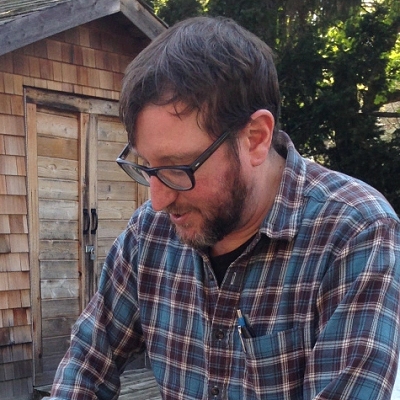
Jeffrey S. Peachey is an independent book conservator, bibliopegist and toolmaker based in New York City. For more than 25 years, he has specialized in the conservation of books for institutions and individuals. He is a Professional Associate in the American Institute for Conservation, has taught book conservation workshops internationally, and was recently awarded a fellowships from the Rockefeller Foundation Bellagio Center(Italy) and Rochester Institute of Technology's Cary Collection (New York). He is also a Visiting Instructor for the Library and Archives Conservation Education Consortium of Buffalo State University, New York University, and Winterthur/ University of Delaware. His most recent publication is "Ausbund 1564: The History and Conservation of an Anabaptist Icon."
More information at: jeffpeachey.com
